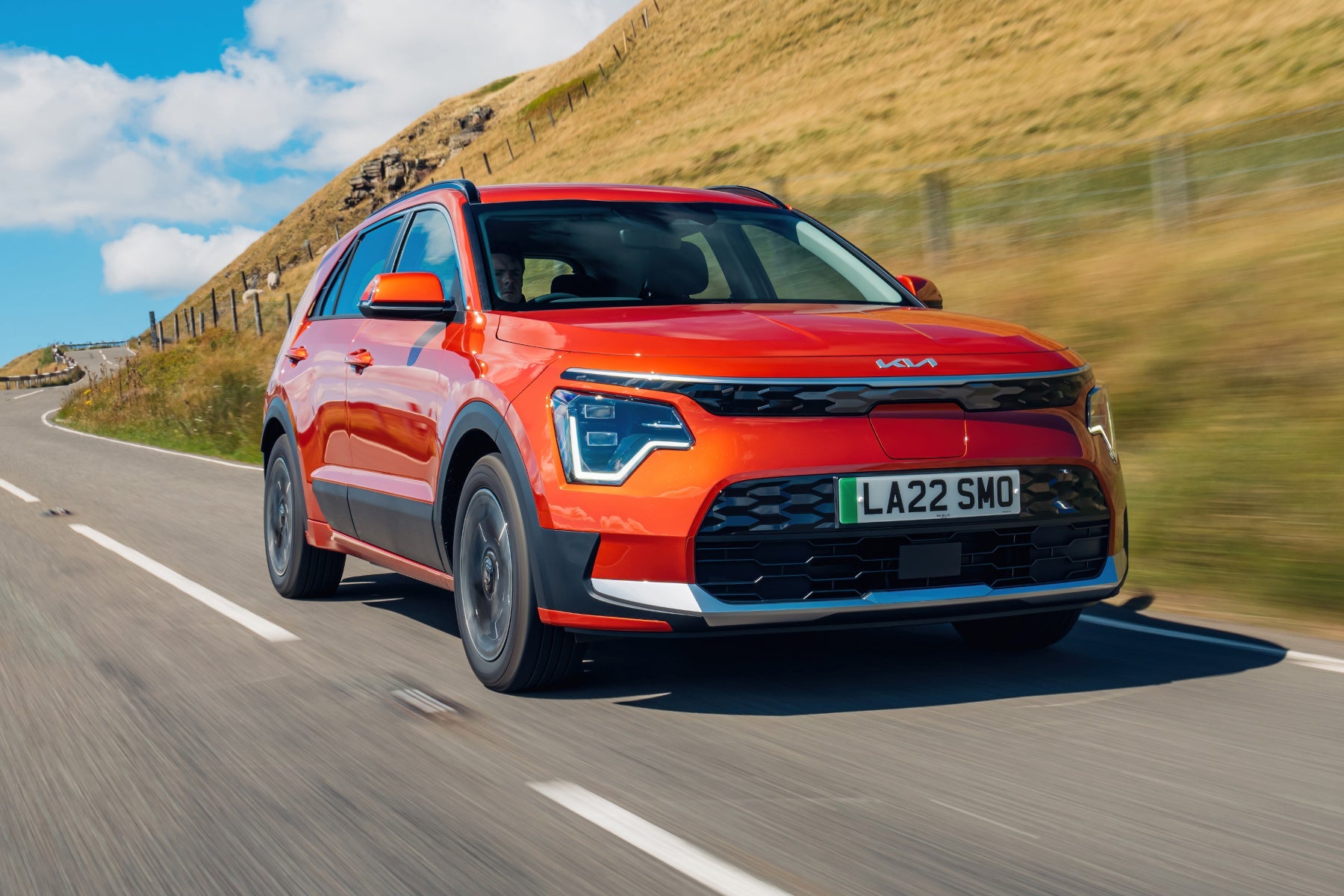Kia Niro EV Review 2025: Price, specs & boot space
Written by Andy Brady
- 2022
- Small SUV
- EV
Quick overview
Pros
- Brilliant all-rounder
- Impressive 285-mile range
- Spacious cabin with user-friendly infotainment
Cons
- Range and performance are hardly any better than the old Kia e-Niro
- Top-spec versions are near the brilliant Kia EV6 on price
- Charging speed is disappointing
Overall verdict on the Kia Niro EV
"It's a case of the 'difficult second album' for the Kia e-Niro – or rather, the Kia Niro EV as it now likes to be known. Kia's used its electric car expertise (as well as features from the ultra-impressive Kia EV6) to make it more desirable. Our Kia Niro EV review will show why this is one of the best all-round electric cars on sale."
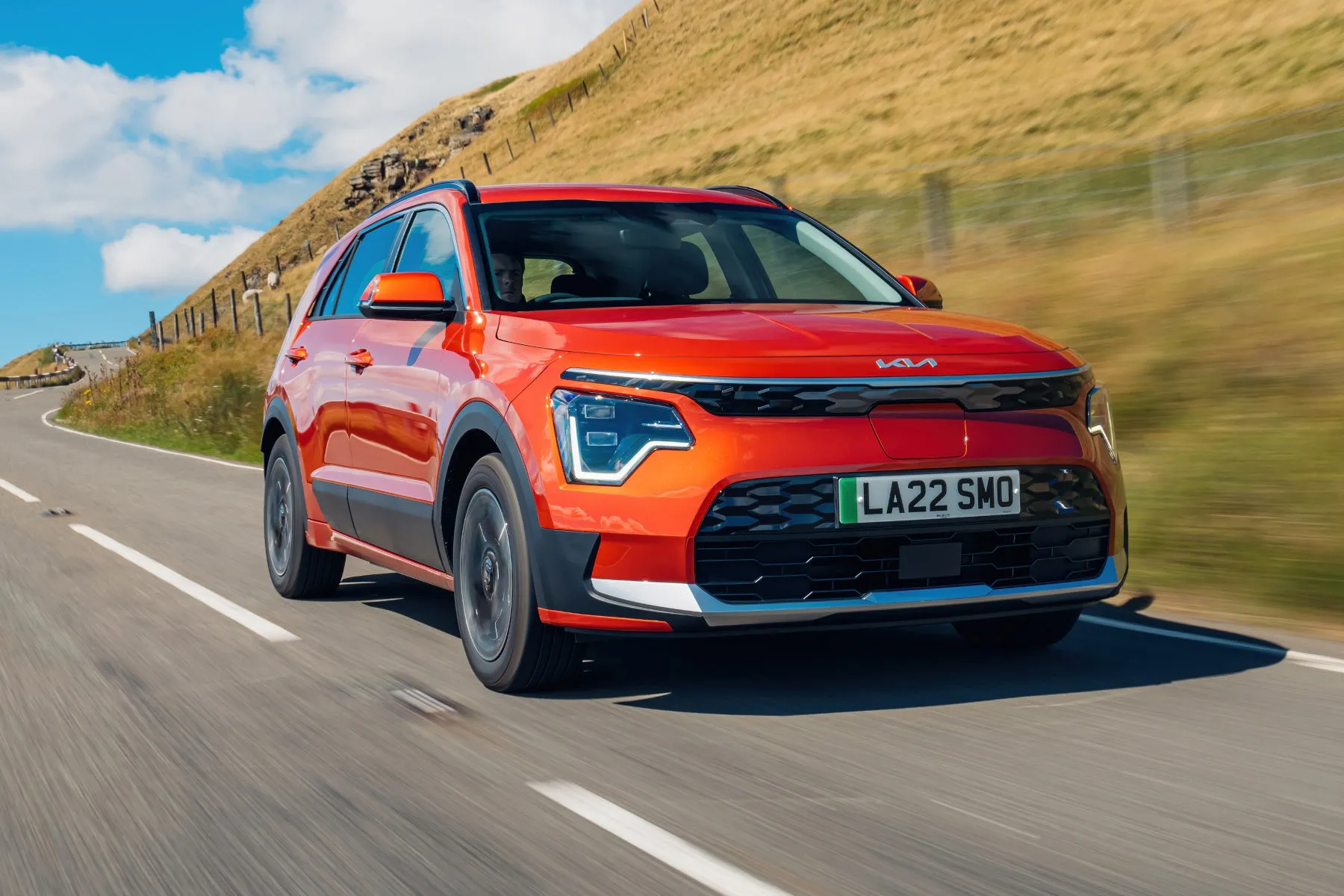
Many people who are switching over to an electric car want an electric SUV, but one that won't break the bank and will slip seamlessly into their everyday life with minimal fuss. The Kia Niro EV could well be that car - keep reading to find out why.
We described the original Kia e-Niro as 'the ultimate electric car' when it first went on sale in 2019. It could travel up to 282 miles between charges, was versatile enough to use as your main family car, and came with a long list of standard equipment - not to mention a lengthy warranty, transferable to subsequent owners.
But the market's moved on since then. Electric cars are no longer niche items - almost every manufacturer churns out new electric vehicles quicker than we can say '2030 combustion engine ban'. If you're in the market for an electric SUV, your options range from the affordable MG ZS EV to the versatile Skoda Enyaq iV or desirable lottery-win offerings like the BMW iX.
Fortunately, Kia hasn't exactly been resting on its laurels. You've probably seen the fantastic Kia EV6 – a desirable electric car with eye-catching styling, impressive performance and a very useable electric range. It's not a cheap option, though, so there remains space in Kia's line-up for more affordable models like the Niro EV and Soul EV.
Just like the old Kia Niro, the new Niro is available as a hybrid, plug-in hybrid or pure-electric model (reviewed here and now badged the Niro EV). And, just like the old model in recent years, Kia reckons the electric version accounts for the biggest chunk of sales - around two thirds, in fact.
The Kia Niro EV uses a 64.8kWh battery (a smaller battery version isn't in the pipeline). This provides a range of up to 285 miles. That's pretty competitive, but it doesn't exactly move the game on compared to its predecessor (the e-Niro could manage 282 miles). It doesn't set records for charging, either – a 10 to 80% charge takes around 45 minutes, which is a long time if you're in a hurry to get somewhere and a bit mediocre in this day and age.
It doesn't accelerate any quicker than the old model, either, although few people drove that and wished it had more power. It'll sprint to 62mph in a plenty-fast-enough 7.8 seconds, while the instant get-up-and-go provided by the electric motor means it feels pretty urgent around town. If you haven't driven an electric car, you're in for a treat.
Kia's engineers have deliberately set the Niro EV up for comfort, which means it's not quite as pointy and agile as a Cupra Born. The steering is light and precise, though, and you can get a plethora of driver-assistance tech to take the hassle out of day-to-day driving. This includes navigation-based smart cruise control, which can slow down for corners or adjust to match the speed limit.
By positioning the batteries low down under the Niro EV's floor, it's even more spacious inside than the hybrid model. That means you get loads of room for all the family, while a flat floor in the rear means you should be able to fit three teenagers side-by-side with few complaints.
While the stats don't represent a huge amount of progression compared to the old Niro, the new Niro EV's interior really moves the game on. It feels futuristic, but not at the expense of usability – anyone who's tried to turn the heated seats on in a Volkswagen ID.3 will appreciate the separate control panel below the screen, although the touch-sensitive 'buttons' are still a little fiddly.
Kia's gone to town with eco-friendly materials in the e-Niro's cabin but, again, not at the expense of quality. Bar the odd cheaper plastic surface it feels almost as classy as the pricier EV6 – and we reckon that's just as impressive inside as premium alternatives like the Audi Q4 e-tron.
Looking for the old model? You'll need our Kia e-Niro (2019-2021) review.
Is the Kia Niro EV right for you?
If you're looking for a comfortable and versatile electric car with a long range, the Kia Niro EV is a solid choice. It's just as impressive as the old model, albeit with a fancier interior and more head-turning styling. It might not be as rapid (or rapid charging) as a Tesla, nor does it move the game on in any particular area, but it's still a well-finished all-rounder for a very reasonable price.
What’s the best Kia Niro EV model/engine to choose?
We'd recommend the mid-spec Kia Niro EV 3. The entry-level Niro EV 2 does without certain desirable features (the bigger infotainment screen, heated seats and driver-assistance tech such as Highway Driving Assist, for example). The top-spec Kia Niro EV 4 is well-equipped but also nudging Kia EV6 prices, which makes it a little more difficult to justify.
What other cars are similar to the Kia Niro EV?
If you're considering the new Kia Niro EV, you should also look at the (slightly more compact) Hyundai Kona Electric as well as the Peugeot e-2008, Citroen e-C4 and Mazda MX-30. The Cupra Born and Volkswagen ID.3 are two more hatchback-like alternatives, as well as the excellent Renault Megane E-Tech, while the slightly bigger Skoda Enyaq iV should definitely be on your shortlist if you're in the market for an electric family SUV.
Other alternatives include the Volkswagen ID.4, the Renault Megane E-Tech and the more affordable but lower-range Vauxhall Mokka Electric.
Comfort and design: Kia Niro EV interior
"The Kia Niro EV's cabin is leagues ahead of the old model, with a cool design, mostly premium materials and infotainment similar to what you'd find in the desirable Kia EV6. There's very little to dislike."
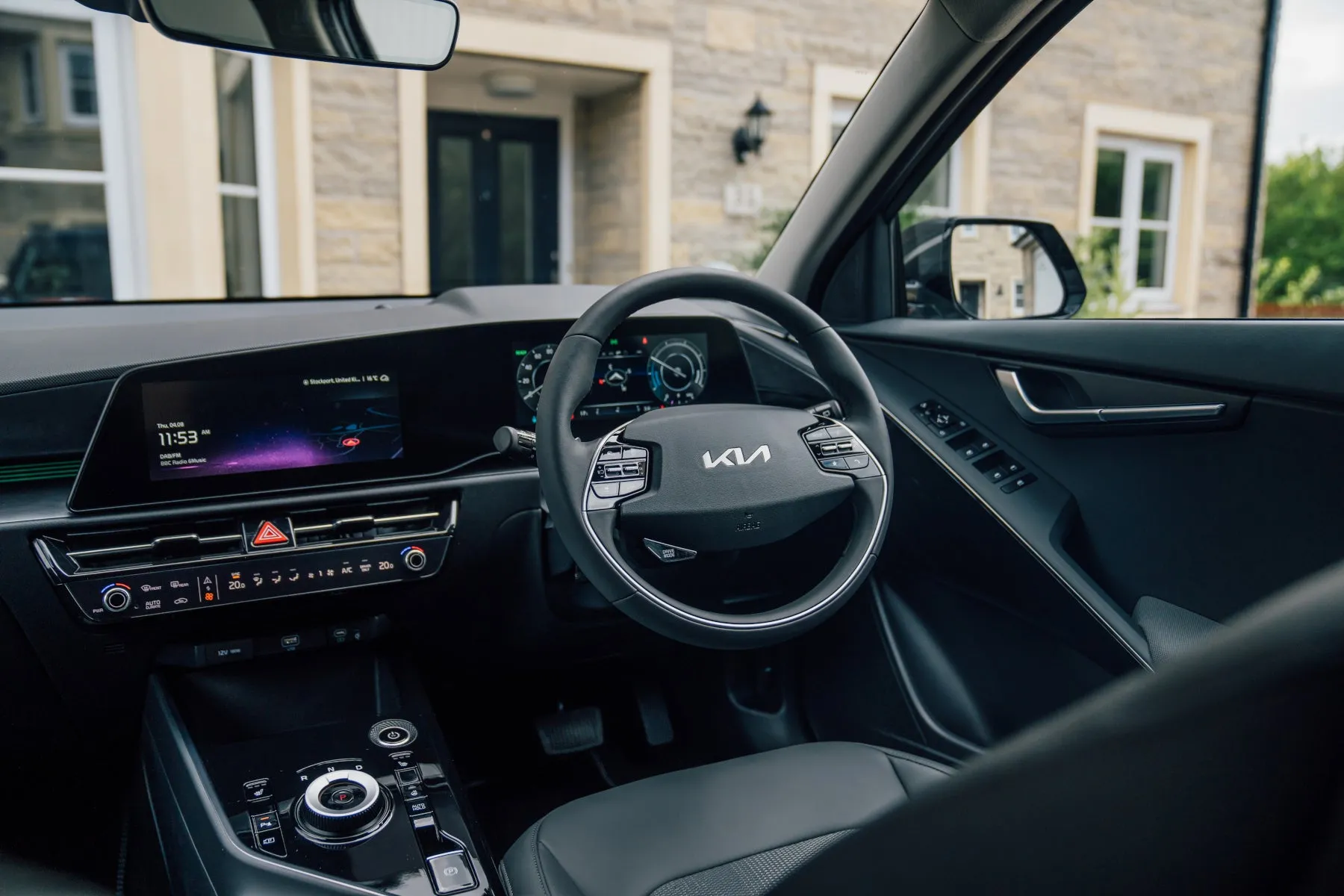
The nice thing about the Kia Niro EV's interior is that, while it feels sufficiently tech-heavy, it doesn't compromise ease of use. It's better than the Volkswagen ID.3 in that regard – everything is pretty self-explanatory and you get a proper volume knob for the stereo, plus a neat control panel separate from the touchscreen itself.
Granted, this control panel doesn't use physical buttons, rather slightly more fiddly haptic touch icons that sometimes require a second stab. But it's still easier to prod on the move than scrolling through menus on a screen, and - praise be - you get proper physical buttons on the steering wheel and banks of switches for key features either side of the drive selector. In this respect it's much like the Kia EV6, and the design is similar inside with its neat dual-screen display panel.
It's comfortable, too, with supportive seats and enough adjustment to cater for people of all shapes and sizes. You don't sit particularly high, even with the seat cranked up to the max, but you don't in the bigger Kia EV6 either.
Although it's expensive, the top-spec Kia Niro EV 4 is the one to go for if you desire a fancy interior. Standard equipment includes ventilated front seats, heated seats in the back, an electric tailgate, a sunroof and a premium Harman Kardon surround sound system. You also get lumbar adjustment for the passenger seats, as well as 'relaxation seating' which reclines fully, allowing you to grab 40 winks while the car charges.
Quality and finish
Generally, the Kia Niro EV feels mostly well-finished inside. There are a few hard plastics here and there, and the interior light panel looks a touch low-rent, but it's a big improvement over the old model (and it definitely feels plusher than the MG ZS EV). Importantly, nothing feels flimsy or cheap, like it would fall apart after five minutes of exposure to your children.
The brand is keen to point out the eco-credentials of the Niro's cabin – the vegan 'leather' seats are made using sustainable materials derived from eucalyptus wood, for example, while the headlining is made from recycled paper. The latter isn't that pleasant to touch, however.
Infotainment: Touchscreen, USB, nav and stereo in the Kia Niro EV
We've tried the basic 8.0-inch media system fitted as standard to the entry-level Kia Niro EV 2 and it does a decent enough job, responding well to the touch and not looking too downmarket. Apple CarPlay and Android Auto are standard, meaning you can access apps from your phone on the central display. You don't get sat-nav on the entry-level car, but we'd recommend using Google Maps anyway as it tends to be slicker and more up-to-date than factory-fit navigation.
Tech fans should look for a Kia Niro EV 3 or 4, though, as this brings a larger 10.25-inch touchscreen infotainment display with in-built navigation. It's logically laid out and quick to respond, so negotiating the menus never feels too much of a faff.
All Kia Niro EV models come with a 10.25-inch digital instrument cluster, which is just as sharp and impressive as the central display. It adds to the upmarket, tech-heavy vibe that the old Kia e-Niro was lacking. The 4 trim also comes with a head-up display to keep your eyes on the road more of the time.
You'll also find wireless phone charging on all except the base model, alongside wired connections for both USB-C and old-style USB. On the back of the rear sears there are also USB C ports - again, like the EV6.
But herein lies a problem: for some reason, if you get the entry-level car you get wireless Apple CarPlay and Android Auto, but if you step up to 3 or 4 spec you only get wired connections for both. A Kia representative told us its because wireless charging is problematic with wireless connections, but other manufacturers manage it.
Space and practicality: Kia Niro EV boot space
For a relatively small electric SUV, the Kia Niro EV is incredibly spacious. It certainly feels bigger inside than, say, a Hyundai Kona Electric or Peugeot e-2008, only really beaten by the family-focused Skoda Enyaq iV in terms of outright space.
Rear passengers in particular benefit from an increase in interior space compared to the old Kia e-Niro, thanks not only to a longer wheelbase but also thinner front seats designed to boost rear legroom. There's loads of headroom, good visibility out (so it doesn't feel claustrophobic back there) and a completely flat floor means you won't be struggling for somewhere to put your feet.
Cabin storage is generally decent enough, with a pair of cupholders with VW-style pop-out holders in the centre console, a decent sized bin under the centre armrest and a good glovebox. The door bins are on the small side, however.
The Kia Niro EV's boot can carry up to 475-litres of luggage, which is more than you'd get in a hybrid or plug-in hybrid Niro. There's an extra 20 litres in the 'frunk' at the front of the car, too – ideal for stowing away your charging cables, but not much else. Still, many electric cars don't have a 'frunk' at all. Fold the rear seats and you can stash away up to 1392-litres of goodies.
In terms of exterior dimensions the Kia Niro EV is - unsurprisingly - identical to the hybrid models. That means it's 4420mm long, 1825mm wide and 1585mm tall.
Handling and ride quality: What is the Kia Niro EV like to drive?
"The Kia Niro EV is comfortable and easy to drive. It'll be a revelation for anyone who hasn't driven an electric car before, thanks to its effortless acceleration and extensive driver-assistance tech."
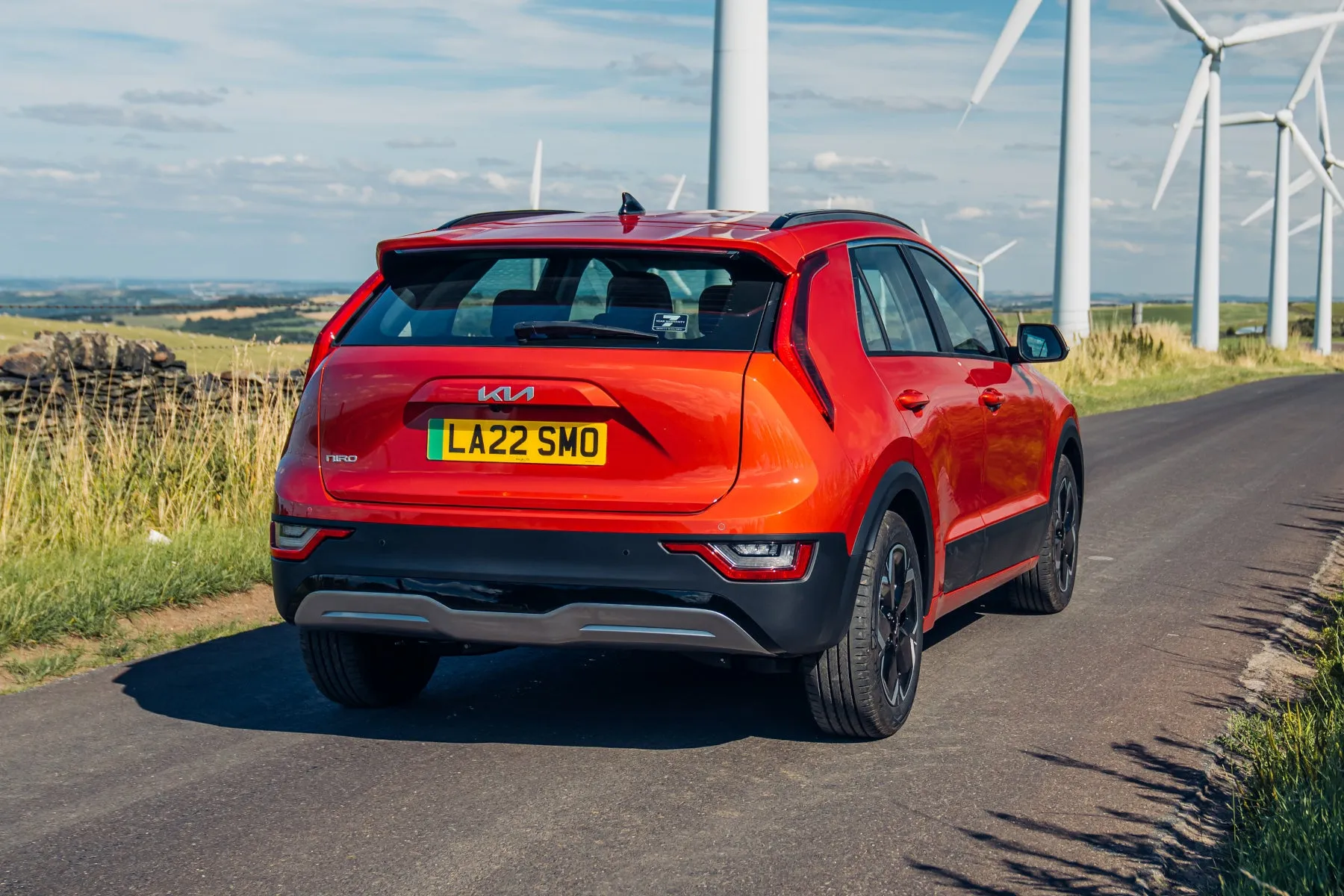
The bigger Kia EV6 is a sportier choice, but we reckon the Niro EV is perfectly judged for the market. The suspension is on the soft side, which means it rides better than a lot of electric cars where the suspension has been firmed up to stop it rolling around in the bends. It's definitely more comfortable and relaxing than the old model.
Granted, there's a fair bit of body lean when you fling it into a faster corner, but it's not drastic. The steering is precise and has enough weight to it to inspire confidence, but remains plenty light enough for town driving. There's also more grip than before - the old e-Niro would spin up its front wheels if you were too vigorous with the throttle out of a junction, but now the smoother delivery stops that.
Visibility is decent, while a standard-fit reversing camera and rear parking sensors help around town. It's not actually that big a car – so you shouldn't feel too intimidated about squeezing it into tight spaces.
Prefer to relax and let the car take the strain on a long drive? Kia's Highway Driving Assist features on 3 spec cars and above. It'll keep the car within its lane on a motorway well enough, and if you tap the indicator it'll change lanes all by itself as long as it's safe to do so.
What motors and batteries are available in the Kia Niro EV?
In terms of motors and batteries, the Kia Niro EV line-up is pretty simple. There's just one option: a 64.8kWh battery pack paired with a 204PS electric motor. It produces 255Nm of instant torque, providing 0-62mph acceleration in 7.8 seconds.
That's ever-so-slightly slower than the old Kia e-Niro, but it's still going to be sprightly enough for most buyers. And it's intentional: Kia has restricted the power delivery a little at lower speeds to stop the Niro EV lighting up its tyres so easily, but once you're above, say, 30mph you feel a bit more of a shove in the back to get you up to speed.
There are three different levels of regenerative braking available, adjusted easily using the paddles behind the steering wheel. With the regen set to max, the car will slow down significantly when you lift off the accelerator – great for driving around town as you'll hardly have to use the brakes. We'd recommend reducing the regen when you're on the open road, though, allowing the Niro EV to coast at speed.
Maximum electric range in the Kia Niro EV
The Kia Niro EV has an official range of 285 miles. That's likely to drop slightly in the real world but, based on our experience with other Kia electric vehicles (including the old e-Niro), you should be able to get pretty close to the official figure with little effort.
When we tested the Niro EV in the UK we crawled around a snarled up London, headed out onto the motorway and drove normally (at 70mph, not mixing it with the lorries) and then took it down some country roads. All of that was in temperatures over 30 degrees, with the air-con working overtime. Despite that, it managed 4.4 miles per kWh - in laymans terms that's 282 miles on a charge. Do lots of town driving with regen braking? That'll be over 5 miles per kWh.
Some 4 trim models come with a heat pump included to prime the battery for optimum charging, or you can add this as an option for £900 to the rest of the Niro EV range.
Refinement and noise levels
Refinement is good for a car of this price and design. Obviously there's no engine noise, but Kia's done a commendable job of ironing out other noises, too, with no whine from the motors. You might notice a bit of wind noise at high speed or road noise on less-than-perfect surfaces, but it's rarely intrusive.
Safety equipment: How safe is the Kia Niro EV?
All Kia Niro EV models come with the brand's Forward Collision Avoidance system (FCA 1.5), able to detect other cars, pedestrians and cyclists and apply emergency braking if necessary to avoid a collision. This is upgraded to FCA 2.0 on the top-spec Kia Niro EV 4, adding features like a junction crossing function (which detects vehicles approaching from the side) and evasive steering assist (which can help you swerve around a pedestrian or cyclist if necessary).
Other driver-assist tech available on the Niro EV include Highway Driving Assist (which helps you maintain a safe distance from other vehicles on the motorway as well as keeping you in your lane), an intelligent speed limiter and a blindspot warning system which can apply the brakes to prevent a collision when you're changing lanes or pulling out of a parking space.
The Kia Niro EV is yet to be crash tested by Euro NCAP, but the Niro has been. It scored a mildly disappointing four stars out of five in standard form, but moved up to a five-star rating when tested with the safety pack.
Charging times: How much does it cost to charge the Kia Niro EV?
"The Kia Niro EV takes around 45 minutes to charge from 10 to 80% at a suitable rapid charger, while a full charge using your home wallbox will take 9 hours and 30 minutes. There's certainly faster rapid charging EVs out there."
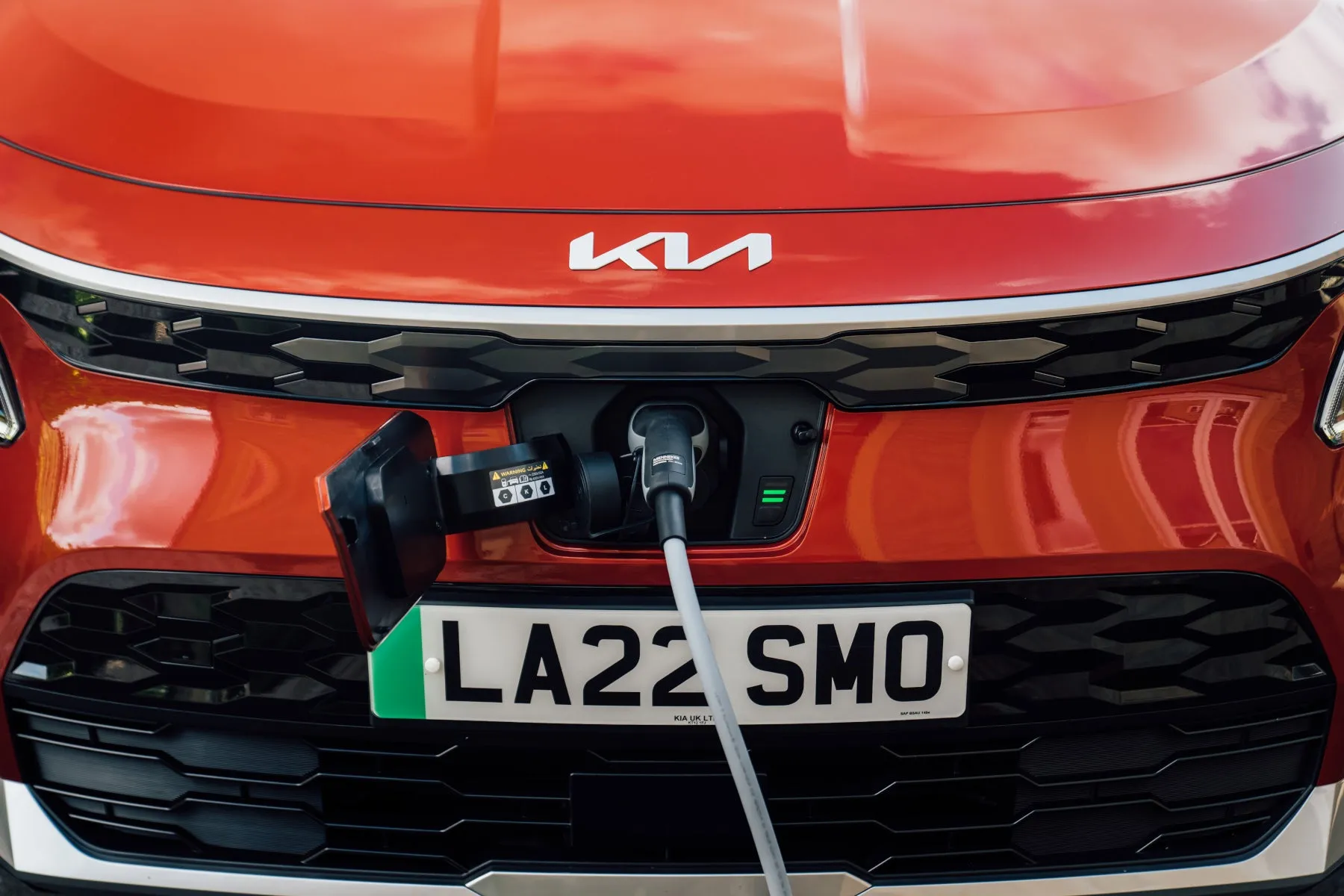
If you're planning to rapid charge regularly, you might want to look elsewhere. The maximum speed that the Kia Niro EV can charge is just 72kW. The bigger Kia EV6 can be rapid charged at a rate of up to 234kW, meaning a 10-80% charge will take just 18 minutes (less than half the time of a Kia Niro EV).
That's probably the most disappointing thing about the new Niro EV. Early versions of the Skoda Enyaq could charge at only 50kW, but last year they were upgraded to charge at up to 125kW. Even the Vauxhall Mokka-e and Peugeot e-2008, which have been around for a while now, have higher peak speeds of 100kW. It's important to stress that 'peak' charge rates aren't always achievable, however.
The Niro EV does have a few tricks up its sleeve to help speed up charging, though. If you use the navigation to find a charge point, it'll pre-heat the battery in order to shorten charge times. That means it can actually be charged nine minutes quicker than the e-Niro (although not as quickly as, say, a Volkswagen ID.3).
Rapid charging is expensive, so a lot of electric car buyers are happy to stick to charging at home the majority of the time. We'd recommend having a 7kW home charger installed in your garage or near your driveway – this'll fully charge the Niro EV is around 9 hours and 30 minutes.
How reliable is a Kia Niro EV?
Don't expect to see many Kia Niro EVs on the back of recovery trucks. Kia as a brand has an excellent reliability record, backed up by its generous seven-year/100,000-mile warranty.
Electric vehicles are generally more reliable than petrol or diesel cars. That's because there are much fewer mechanical parts in an EV – there's no engine oil or drive belts to need changing, for example, while the batteries generally last longer than the average lifespan of a car. That's not to say a software issue won't crop up, but the same applies to high-tech petrol and diesel cars these days.
Kia came an impressive eighth in the latest HonestJohn.co.uk Satisfaction Index while the old Kia Niro was ranked in the top 20 most reliable used cars.
Insurance groups and costs
The Kia Niro EV 2 has been placed into insurance group 28A, while the 3 and 4 models are in insurance group 29A. That means the entry-level model should, in theory, be the cheapest to insure – but the difference in reality will probably be minimal.
As always, we'd recommend searching for some insurance quotes before paying a deposit on a Kia Niro EV. Electric cars are becoming more popular but they are still seen by some insurers as specialist vehicles which could be expensive to repair, so they might attract a premium compared to a petrol or diesel car.
VED car tax: What is the annual road tax on a Kia Niro EV?
As a pure-electric vehicle, you won't pay anything for your annual car tax (VED). Even Niro EV models with a list price of more than £40,000 (that's the top spec Kia Niro EV 4) are exempt from the usual premium car surcharge – which means you are saving that £490 charge each year plus the £190 for road tax by going electric.
How much should you be paying for a used Kia Niro EV?
"As you can no longer get a government grant towards a new electric vehicle, the latest Kia Niro EV is slightly pricier than its predecessor. However, there are healthy savings to be had by choosing a pre-registered or nearly new car."
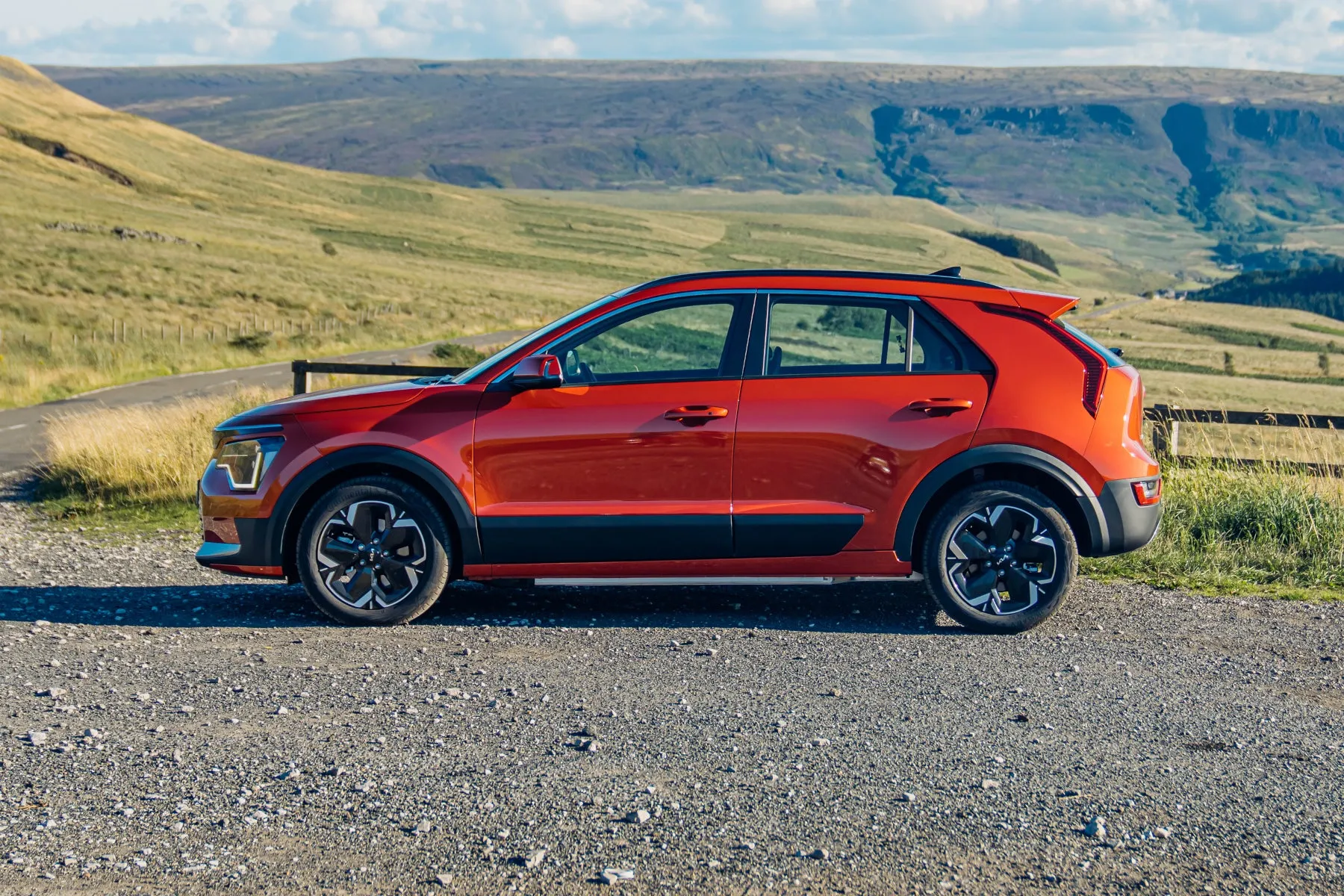
If you can put up with owning a car that has covered around 1000 miles since it was first registered, then you can look forward to a saving of around £10,000 on the list price of a Kia Niro EV 3. That is a whopping 25% reduction for the sake of a few miles. We'll take that.
For a two-year old Kia Niro EV with 15,000 miles to its name and in 2 trim, you will find these for around £23,000.
Trim levels and standard equipment
The Kia Niro EV is available in three trim levels: 2, 3 and 4.
The range kicks off with the Kia Niro EV 2, which features 17-inch alloy wheels, LED headlights, cloth seats, a dual-height boot floor, rear parking sensors and camera system, an 8.0-inch touchscreen display with DAB radio, Android Auto and Apple CarPlay, and a 10.25-inch digital instrument cluster cluster. In addition, standard driver assistance technologies include Forward Collision Avoidance with car, pedestrian and cyclist recognition and junction crossing and Smart Cruise Control.
The Kia Niro EV 3 adds a larger 10.25-inch touchscreen with navigation, cloth and faux leather upholstery, front parking sensors, keyless smart entry and start, and heated seats and steering wheel. Equipment also includes rear privacy glass, driver lumbar support, Highway Driving Assist (HDA), Blind Spot Collision Avoidance (BCA) for the rear, a wireless smartphone charger, and adjustable multi-angle rear seats. The Kia Niro EV 3 also features vehicle-to-device functionality with a three-pin socket as standard, allowing you to power external electrical devices.
Topping the range, the Kia Niro EV 4 adds a head-up display, twin 10.25-inch touchscreen and instrument cluster display, heated rear seats and ventilated front seats (trimmed in vegan leather), front passenger premium relaxation seating, a power operated tailgate, electric sunroof, a Harman Kardon premium sound system, driver’s side memory seating, and front passenger lumbar support. Additional tech includes Remote Smart Parking Assist, Parking Collision-Avoidance Assist, Highway Driver Assist 2 and Forward Collision Avoidance 2.
Ask the heycar experts: common questions
Is the Kia Niro fully electric?
Is the Kia Niro EV a good electric car?
How much does a Kia Niro EV cost?
Get our latest advice, news and offers
Keep me updated by email with the latest advice, news and offers from heycar.
By submitting you agree to our privacy policy
